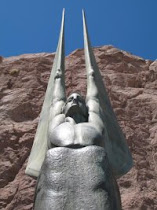
Several months ago I posted a video of a man (Philippe Petit) who in 1974 tightrope walked between the towers of the World Trade Center. Last night I was able to see a preview screening of Man on Wire, a new documentary about this same event.
The movie used extensive footage from the time, contemporary interviews with the players, and dramatic re-enactments using actors. It was all interwoven very well, and despite "knowing" the outcome, it managed to be filled with tension and suspense. But it also had moments of comedy and great awe.
It was quite incredible. Not only was the act itself amazing, they had a large amount of footage of Petit and crew as they made their preparations. Clearly, they realized at the time what a momentous undertaking they were attempting. The players involved were interesting people with unique perspectives and motivations, making it just as interesting to hear their stories.
It was truly a fantastic tale well told, and I highly recommend it.
Now that my brief review is done, I want to talk about something else in the movie that bothered me.
The spectre of the attacks of 9/11 will forever haunt the World Trade Center. I don't think it is possible for anyone alive at the time to not associate the Twin Towers with that tragedy. And I don't mean that as a bad thing, it just is.
I think the filmmakers for Man on Wire must have been aware of this, and their movie, in a way, is an attempt to glorify the towers, and to restore some of the awe and beauty that they once inspired. No mention is ever made of the attacks, since they have nothing to do with the story they are telling.
But what bothered me were several haunting juxtapositions that hinted at the tragedy without acknowledging it.
The first was the most jarring to me. The main character, Philippe, is talking about the danger of the stunt and the risk of death. He says, "Yes, I knew that I could die. But what better way to die is there? To die while you are pursuing that which you are most passionate about." While he is speaking, the visuals cut from him to a shot of an airliner. It hangs for a few seconds before turning to descend into an Australian airport. To me, that brought images of both the terrorists sacrificing themselves for their cause and the passengers who fought back on United 93.
Throughout the film, there was a very Indiana Jones-like map showing Philippe's travels to and from New York. But at the head of the red line, there was a computer model of an airliner. When it reached its destination, it seemed to nose-dive towards the map.
Lastly, there was a picture of Philippe as he was on the wire. It was a black and white shot taken from below, and above and behind him is another large airplane, seemingly aimed right at one of the towers.
Everything in film is intentional. The filmmakers had to be aware of the eeriness of these images, yet they chose to use them anyway. I found it unsettling. Am I overreacting? Perhaps. They could have kept Philippe's quote in the first example, but used a different cut scene. They didn't need an airplane at the head of the traveling line. They could have cropped the photo or used any number of others without the airplane.
But should they have?
I am not so sensitive that I think one shouldn't mention or allude to the attacks. As I said earlier, one can't help but think of the attacks in association with the towers. What bothered me about it was that they never directly mentioned it.
It wasn't enough that there was an elephant in the room that nobody talked about, but they also kept cracking peanuts and making elephant sounds while not acknowledging the large beast. To me, you can't have it both ways. They should either say something or say nothing. Without acknowledgment, the little hints seemed cheap and tacky.











2 comments:
I haven't seen this yet, but I listened to my favorite movies podcast (Filmspotting) over the weekend, and they raved about this film. They also commented on the intentional direction to make no references to 9/11. Unlike you, though, they really liked the approach, especially the shot of the airliner over his head as he walked the wire. I've gotta see it.
I saw the film last night. I loved it. However, I felt angered by the exact points in the film that you are describing. I also felt that the filmmakers must have been using this intentionally. I couldn't tell WHAT their intention was, but to show airplanes so many times in the movie? Clearly not an accident. What bothered me the most was that I felt the imagery to be emotionally manipulative, part of the tension-building in telling a story with an ending we already know. Now, that might not be what the filmmakers had in mind, but that's just how it felt to me. Even if their motive was truer (showing that all life is fragile, to be held sacred in the moment, as the protagonist himself suggests at the end), why include these shots at all? Do the filmmakers really have the right to try to instruct us about how to feel about 9/11? Again, I'm not sure WHAT they were doing with this imagery, but I'm trying to consider the different alternatives, and I don't like any of them.
Regardless, a really excellent story.
Post a Comment